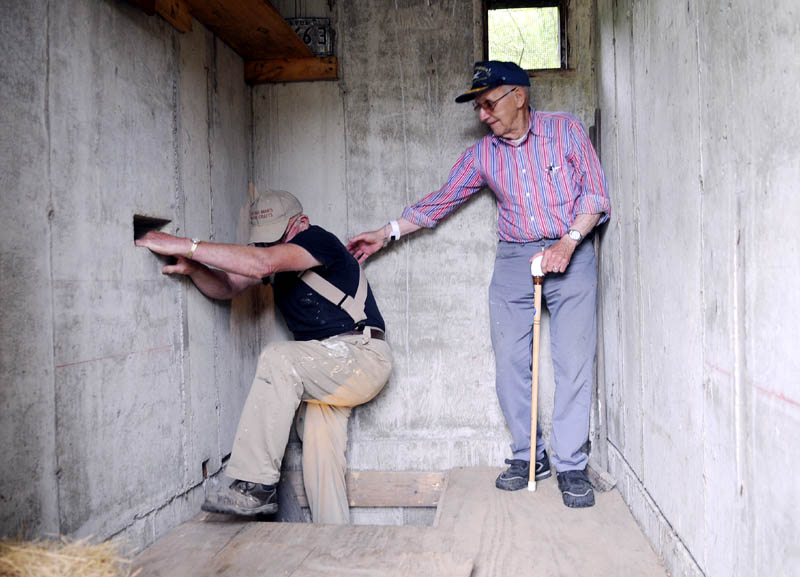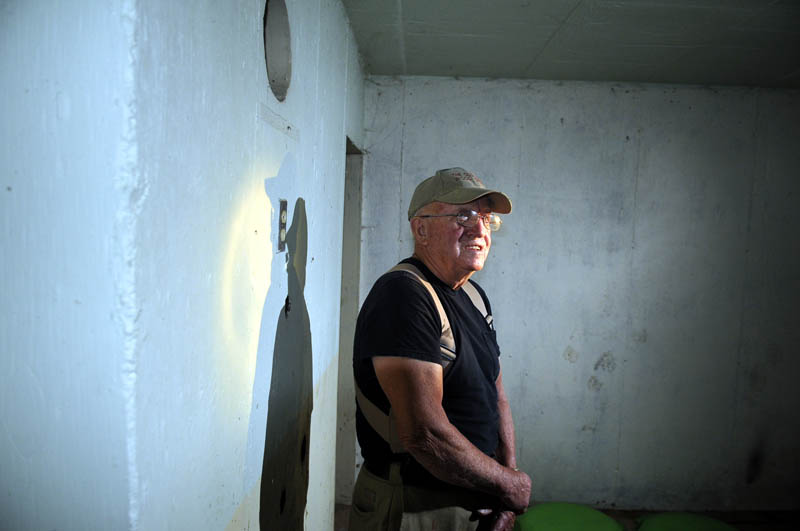AUGUSTA — A Cold War-era bomb shelter built by a local veteran to withstand nuclear attack won’t survive a much more benign offensive: Augusta’s upcoming sewer line replacement. In the 1950s, longtime Augusta resident and World War II tail gunner Donald Tuttle built both a home for his family and — out back next to Bond Brook — a bomb shelter meant to protect them at 180 Mount Vernon Ave.
At the time, Tuttle said, Americans were encouraged to build bomb shelters, for protection in case of Russian attack.
“The Cold War was going on, the Russians got the hydrogen bomb … people built these (bomb shelters) all over the country,” the affable, outspoken 86-year-old Tuttle said. “There was no permit to get. I just built it. They were encouraging people to build them.”
The underground concrete shelter, which is entered through a backyard shed also made of concrete, is now in the way of an upcoming major sewer upgrade project by the Greater Augusta Utility District.
The $17.3 million project, starting this week, aims to prevent a combination of human waste and stormwater from overflowing into Bond Brook during rainstorms.
The project includes the replacement of an old sewer line running between Mount Vernon Avenue and Bond Brook with a new, larger sewer line.
The line and a manhole to access it is planned for about where the bomb shelter now resides.
Brian Tarbuck, general manager of the Greater Augusta Utility District, said the alignment of the pipe, and the close proximity of the home and other structures at 180 Mount Vernon Ave., and Bond Brook, require the pipe to go where the bomb shelter is now.
“It has to go,” Tarbuck said of the bomb shelter. “We tried to move around it, we talked about it at length. But there really is nowhere else to go.”
Tuttle, who now lives in an underground home he built in north Augusta, lived on Mount Vernon Avenue for some 27 years. His nephew, Norman Nadeau, owns the home with the bomb shelter now.
But Tuttle, who drove a concrete truck for 30 years after the military, would like to see the bomb shelter he built of concrete and donated rebar — which he strapped to the bottom of his old Saab to take home — remain.
“It’s too bad they’re going to tear it out,” Tuttle said. “It’s an icon. A Cold War icon. It seems like a waste.”
The bomb shelter has vents for fresh air and had electricity running to it until Tuttle disconnected it because of a bad wiring. The underground part of the shelter has two rooms — one about 10-by-12-feet, the other a bit smaller.
Even the roof of the shed atop the shelter is concrete — Tuttle said he dumped a pile of rock in his driveway so he could get a concrete truck high enough to pour concrete for the roof.
The above-ground shed is painted red, and decorated with flowers. “It used to just be plain concrete, not painted like that,” Tuttle said of the walls of the structure. “Some people who lived here after me painted it like that — hippies I guess.”
The concrete walls of the shelter are between 8 and 10 inches thick.
Roland Arno, Nadeau’s father-in-law, now lives in the home at 180 Mount Vernon Ave. He said he wishes the bomb shelter could be saved, as does Nadeau.
“I wish they wouldn’t take it, I was hoping they could go around the back side, I don’t see why they couldn’t,” Nadeau said Friday. “I’d love to have it stay, but there’s nothing I can do. I argued with them, but they said it’s got to go through it.”
The utility district paid Nadeau $3,500 for an easement to cross the property, and remove the bomb shelter. He said they initially offered $1,000, but he sought more, partly because he knows how much work Tuttle, his uncle, put into the shelter.
Nadeau, who bought the home last winter, hasn’t used the shelter, but said he intended to fix it up and use it for storage and to keep garden vegetables.
Mike Stein, a project engineer for the utility district, said via email that the pipe and manhole need to go through the shelter because of a tight fit between the area homes, Bond Brook, and the existing sewer line.
Tuttle said he and his late wife went down into the shelter during a couple of bad thunderstorms, but other than that never used it, other than as storage for vegetables.
Tuttle and Tarbuck, from the utility district, both anticipate it’ll take some heavy equipment to bust up the walls of the bomb shelter and remove it.
Tarbuck said the shelter shouldn’t have been built so close to the existing sewer line, anyway. “I don’t understand how that was built there in the first place,” he said.
But he acknowledges the shelter is “cool” and, once the district realized it was there, said they tried to work around it, but were unable to do so.
“We just thought it was a shed, with a concrete apron or something,” Tarbuck said. “We certainly didn’t go into this expecting to find an old concrete box down there. It was a surprise. We seem to have found everything you can find on this project.”
Keith Edwards — 621-5647
kedwards@centralmaine.com
Send questions/comments to the editors.





Comments are no longer available on this story